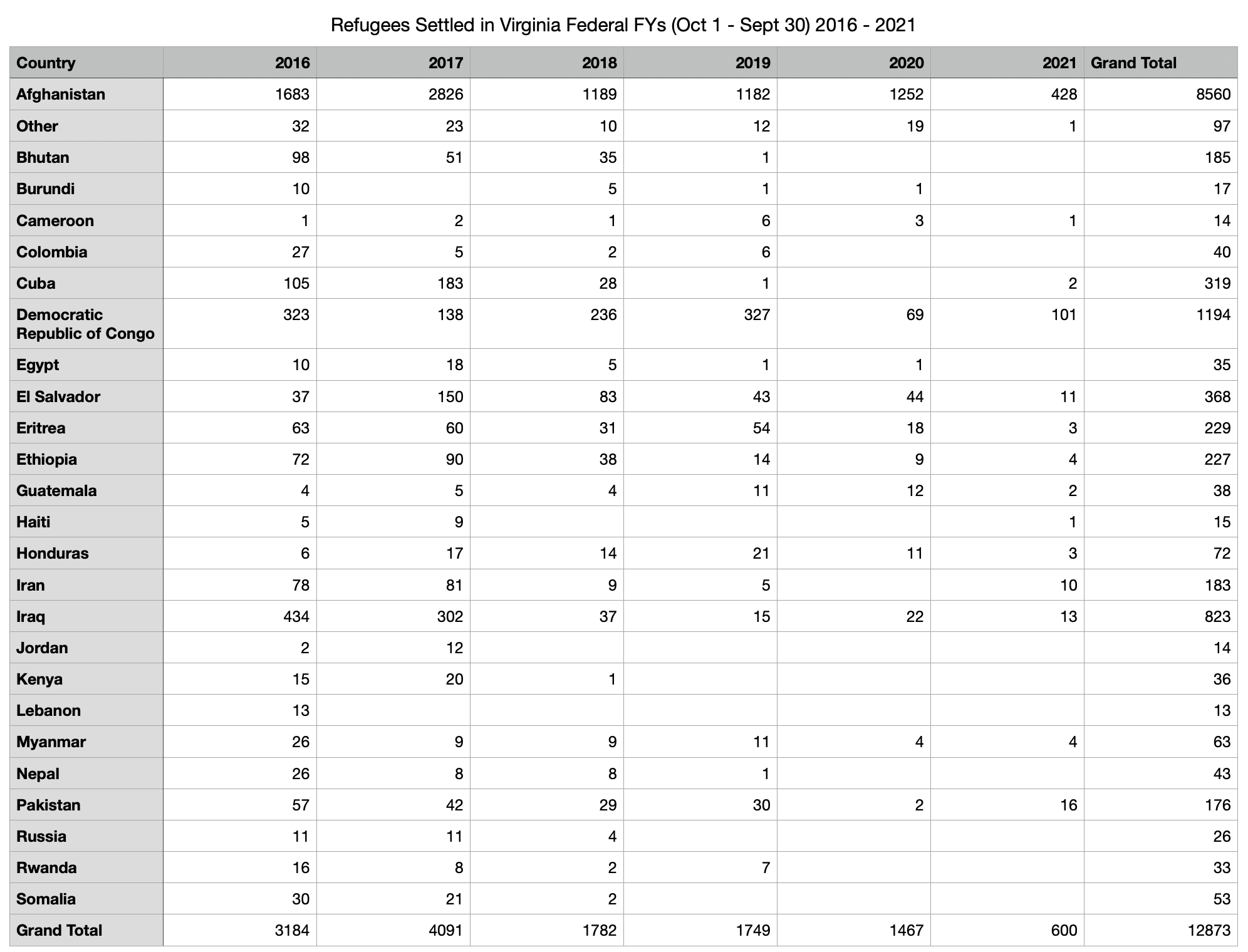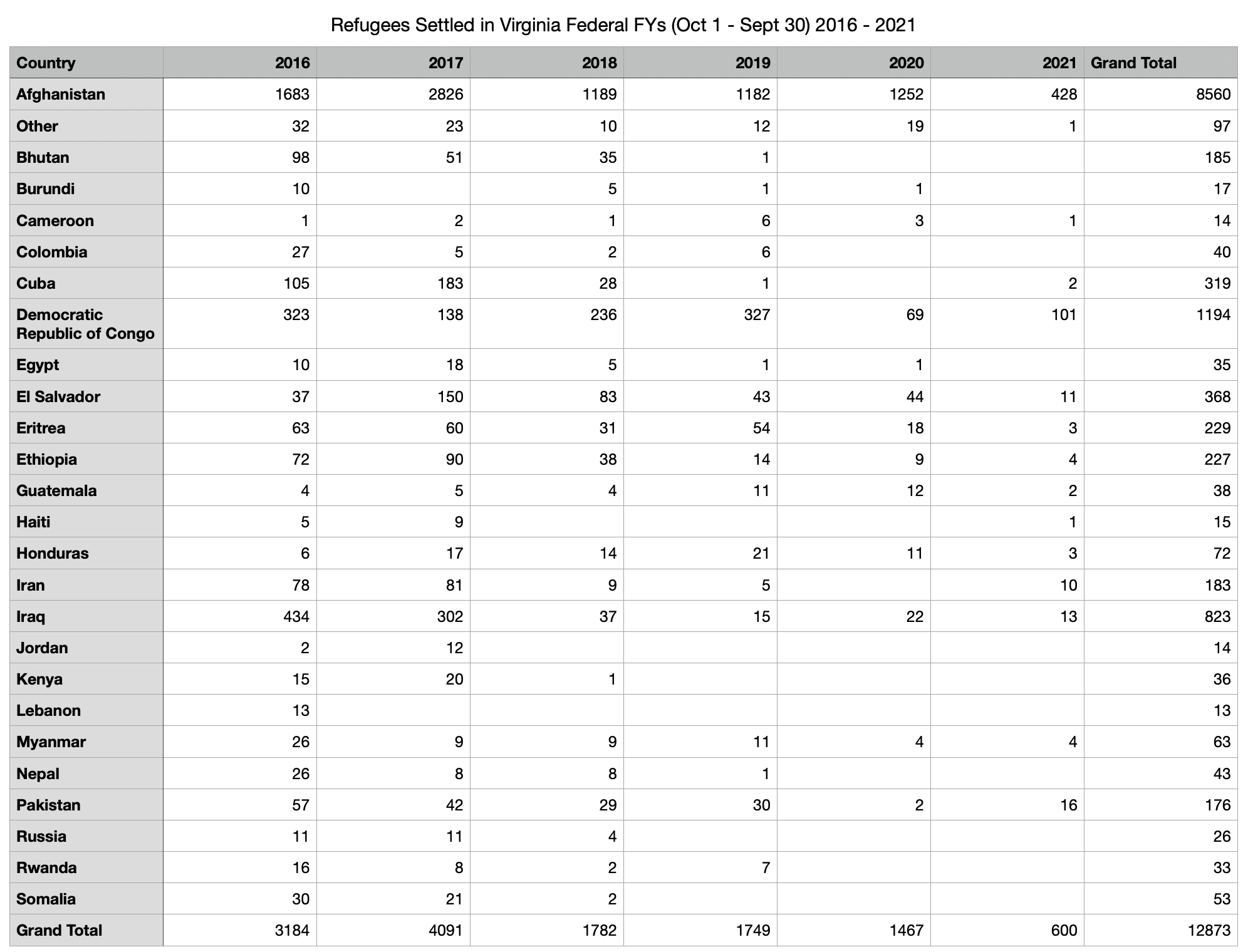By James C. Sherlock
Happy New Year and welcome to everyone in Virginia granted refugee status by the federal government.
You are the latest part of a tradition of welcoming refugees that predates the republic.
The definition of refugee is:
Any person who is outside his or her country of nationality or habitual residence, and is unable or unwilling to return to or seek protection of that country due to a well-founded fear of persecution based on race, religion, nationality, membership in a particular social group, or political opinion.
That status must be both claimed and granted by the federal government.
Claiming refugee status, as many of the millions swarming over the southern border do, is not the same as being granted that status. Those without criminal records and not automatically eligible because of their countries of origin are allowed to remain until a judge rules on their claim.
Virginia has a high-functioning state agency, the Office of Newcomer Services (ONS) in the Virginia Department of Social Services (VDSS), and a number of private non-profits, who help them settle and get started with the aid of federal funding.
From Oct 1, 2015 through the end of September 2021, Virginia resettled 12,873 persons with refugee status, a large majority of whom did not come from the Americas.
The three largest sources of persons granted refugee status and re-settled in Virginia over that period were from Afghanistan (8560), Democratic Republic of the Congo (1,194), and Iraq (823).
The only significant source of those from the Americas was El Salvador (368).
I will update this list as soon as the 2022 numbers are available, but they will include for the first time refugees from Ukraine, now given special refugee status by the U.S. government.
Here are the numbers through from October 1, 2015 through Sept. 30, 2021.
There will be a lot more Afghanis and an unknown number of Ukrainians added to that list when it is updated. I have a lot more information on the Afghani refugees that I will share in a later piece.
Refugee types. As for status of the refugees, here are the types of status for refugees on that list.
- Asylees: individuals who, on their own, travel to the United States and subsequently apply for/receive a grant of asylum. Asylees do not enter the United States as refugees. They may enter as students, tourists, businessmen, or even in undocumented status. Once in the U.S., or at a land border or port of entry, they apply to the Department of Homeland Security (DHS) for asylum;
- Central American Minors (CAMs): certain qualified (unmarried, under 21 years old) children who are nationals of El Salvador, Guatemala, and Honduras, as well as certain family members of those children;
- Cuban/Haitian Entrants: a current or expired parole, who are in pending removal proceedings, or who have a pending application for asylum are Cuban/Haitian Entrants and thus are eligible for Office of Refugee Resettlement (ORR) benefits and services, same as a refugee;
- Special Immigrant Visa (SIV) Holders: for their service to the U.S. government in Iraq and Afghanistan, certain Iraqis and Afghanis are granted Special Immigrant (SIV) status overseas by the U.S. Department of State and are admitted to the U.S. by the Department of Homeland Security. If SIV holders arrange their own travel and elect to receive resettlement assistance after they arrive to the U.S., they are known as walk-in SIV holders.
Virginia Resettlement Agencies and Unaccompanied Refugee Minor Foster Care Programs.
Virginia’s Refugee Resettlement Program supports refugees with social integration and economic assistance.
Support services available to refugee-eligible clients include employment, health, education, youth mentoring, services for older refugees and foster care for unaccompanied refugee minors through the Unaccompanied Refugee Minor Foster Care (URM) program.
VDSS works in partnership with the U.S. Department of Health and Human Services and federally-contracted agencies to administer the URM program.
Virginia Resettlement Agencies.
Unaccompanied Refugee Minor foster care programs.
Ukraine. As for Ukraine, on March 24, 2022 the administration, with a gratuitously political preamble about
especially vulnerable populations such as women, children, lesbian, gay, bisexual, transgender and intersex (LGBTQI+) persons, and persons with disabilities
announced plans
to welcome up to 100,000 Ukrainians and others fleeing Russia’s aggression through the full range of legal pathways, including the U.S. Refugee Admissions Program.
That policy, minus the preamble, is the right thing to do.
But the administration, as it found irresistible, soiled the welcome with a shout out to its cherished special victim classes. Everyone but straight white men.
I guess they can come too, though most are fighting the Russians alongside gay fellow soldiers.
The Ukrainian army, like our own armed forces, honors doctrine of no soldier left behind. They risk and forfeit their lives every day to find and return both the wounded and the dead, gay and straight.
I suspect the straight soldiers and their families find little comfort in knowing they will have to lose a limb and survive to be welcomed here by the President.
Approximately 85,000 Ukrainian citizens reportedly have arrived so far through the program, which requires them to have a sponsor and enables them to stay for up to two years.
Virginia does not have any high concentrations of Ukrainians who might sponsor, though non-Ukrainian Virginians may have stepped up.
For percentages of Ukrainians in towns and cities in Virginia, see here. Not one with more that 10,000 residents has as high as 1% Ukrainian population. The only Virginia town or city with more that 1,000 Ukrainian residents at the date of those numbers was Virginia Beach, the largest.
We had 1,180 Ukrainians out of 421,323 residents.
Ukraine before the war produced annually more that four times as much oil as it consumed. Of the 50 towns in the United States with the highest percentages of Ukrainians, most are oil towns in Pennsylvania (28) and North Dakota (5).
The largest is Frackville PA.
Bottom line. Next time, I will discuss where in Virginia refugees have been resettled by those organizations and the age groups of the refugees upon resettlement to assess the impacts on schools and other services.
But as far as I am concerned, they are welcome and I wish them well.
In Virginia they are well served.









